Persecutory delusion: definition, causes, symptoms, and treatments
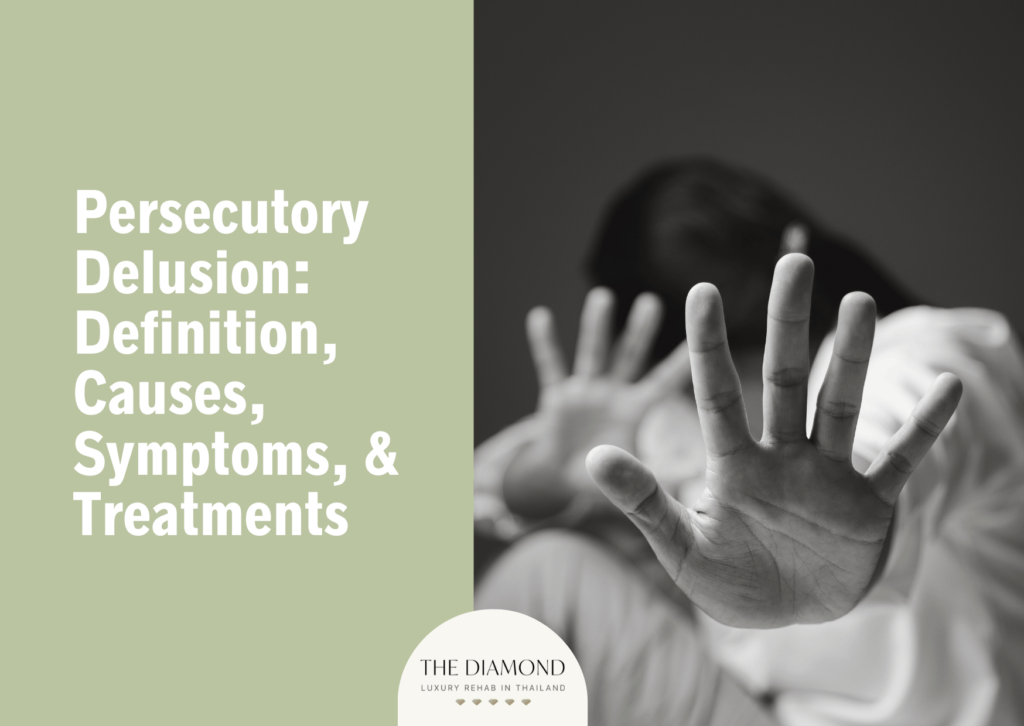
Persecutory delusion is a type of delusion where a person believes someone wants to harm them. A person with the delusion of persecution is convinced the other individual (or more people) threatens them, wants to kill them, or is spying on them.
People with this type of delusion often believe the government is tracking their every move. Since delusion is a false belief, people with persecutory delusions keep on believing in their paranoid theories even when no evidence confirms them.
Causes of persecutory delusion are genetics, environmental factors, and brain abnormalities. It’s useful to mention that several mental health problems are associated with the development of persecutory delusion. These include delusional disorder, schizophrenia, bipolar disorder, depression with psychotic features, and schizoaffective disorder.
Symptoms of persecutory delusion include being convinced that someone threatens or wants to do harm, becoming argumentative or violent when people question the delusion, reporting everything to authorities, and believing the authorities in question are involved as well.
People with persecutory delusions tend to talk in vague terms, experience mood swings, and believe that nobody wants to help them, not even their friends and family. In fact, they’re often confused why their friends and family don’t share the same concerns as they do.
Treatments for persecutory delusion revolve around therapy, but medications and hospitalization are additionally necessary. Hospitalization is recommended for the most severe cases.
What is persecutory delusion?
Persecutory delusion is a false belief where a person is convinced that the other individual, or a group of people, poses a threat or wants to harm them despite evidence to the contrary. Delusion of persecution is persistent and represents a misinterpretation or wrong perception of reality.
In the Diagnostic and Statistical Manual of Mental Disorders, Fifth Edition (DSM-5) by American Psychiatric Association, persecutory delusions are categorized as a type of delusional disorder.
While people with persecutory delusions are paranoid, this type of delusion is not a synonym for paranoia. Persecutory delusions and paranoia are related, but their thought processes are different.
A person with paranoia is doubtful and fearful of others. They can’t trust people due to their intense feelings. Persecutory delusion occurs when paranoia becomes extreme i.e., when paranoid feeling becomes a fixed belief that a person doesn’t change, even when presented with opposing evidence.
The history of persecutory delusion is associated with German psychiatrist Emil Kraepelin, who was the first person to describe delusional disorder back in 1883. Kraepelin identified persecutory delusions and other types of delusions, such as grandiose, jealous, erotomanic, and hypochondriacal. According to Kraepelin, delusions derive from a deficit in judgment resulting from environmental stress and constitutional factors.
For numerous years, psychiatrists and psychologists attempted to explain delusions and their causes. This is particularly the case with paranoia, which stems from ancient times. However, in 1977, American psychiatrist George Winokur re-described paranoia under the term delusional disorder.
The most significant event in the history of delusional disorder was its introduction to DSM-3-R in 1987. From that point on, the delusional disorder was a specific, standalone mental condition.
When discussing the history of persecutory delusion, it’s impossible to avoid the historical background of paranoia, because this type of delusion is a severe form of paranoia. The term paranoia comes from the Greek word par-a-noy’a, which is derived from the verb para-noeo, meaning derangement or departure from normal thinking.
The word first appeared in the works of Greek tragedians Aeschylus, Euripides, and Aristophanes as well as the great minds of Plato and Aristotle and the physician Hippocrates.
At that point, the word paranoia was used as an equivalent of high fever or delirium. A 2019 article written by Thomas A. Ban for the International Network for the History of Neuropsychopharmacology explained that the word paranoia was used in Ancient Greece, either in the same sense as “insanity” and “madness”, or more loosely than we do when we use the terms “folly” and “crazy”.
Paranoia was used as a synonym for a mental illness for a long time. The term reappeared in the 17th century, more precisely in 1621, when Robert Burton, an English author and fellow of Oxford University, published his well-known work The Anatomy of Melancholy.
Burton gave a new, more modern meaning to the concept of paranoia. For Burton, paranoia goes hand in hand with depression. Burton and his contemporaries considered paranoia as a sign of depression, not madness. This link with depression persisted until the rise of professional psychiatry in the late 18th and early 19th centuries.
In 1818, with German physician, Johann Christian August Heinroth, paranoia entered psychiatric nosology as a disorder of thought with unaltered perceptions. Heinroth conceptualized paranoia as a disorder of intellect with preserved feelings and will. French and German psychiatrists agreed on the concept of paranoia as a partial psychosis with a maintained level of functioning and absent deterioration.
In 1863, German psychiatrist Karl Ludwig Kahlbaum published his work where paranoia becomes a distinct nosologic entity or a primary disease with the necessary qualifications for clinical use.
During the ensuing years, there was considerable effort to widen the scope of paranoia or to possibly include it in broader diagnostic concepts. For example, in 1878, a German psychiatrist Karl Friedrich Otto Westphal described acute paranoia. In 1910, a German-Swiss psychiatrist Karl Jaspers published a seminal paper that suggested that paranoid development is influenced by the environment or previous experiences.
Today, paranoia itself is not a mental illness, but it is considered a symptom of other conditions including schizophrenia, paranoid personality disorder, or dementia.
How common is persecutory delusion?
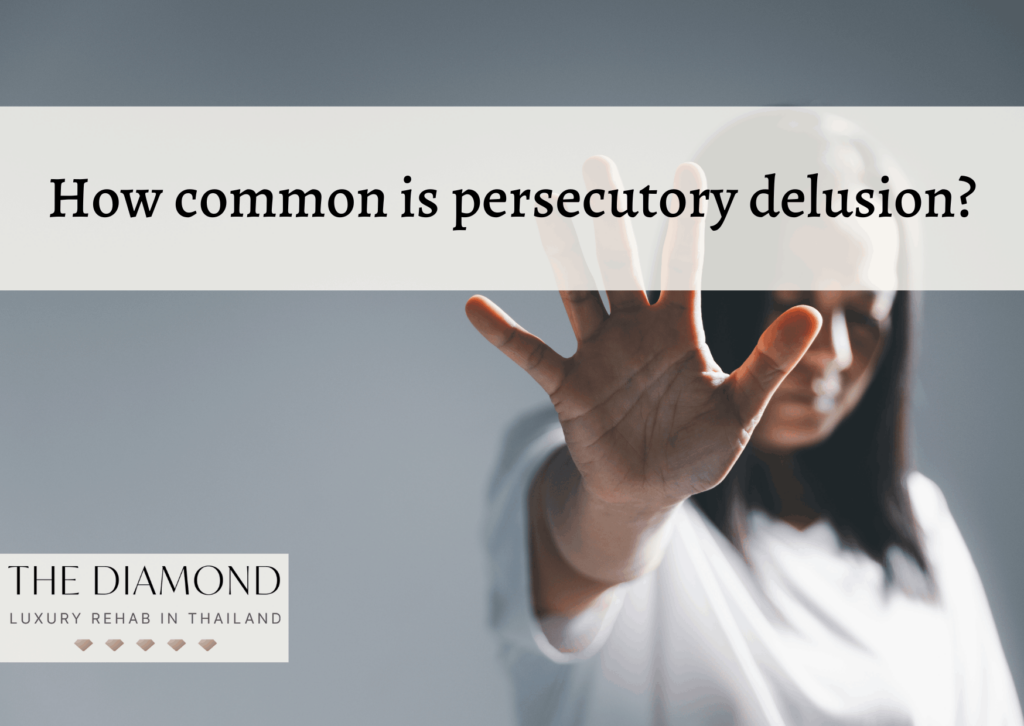
Persecutory delusion is common. In fact, it is present in over 70% of those diagnosed with schizophrenia, according to a 2016 study by Freeman et al., published in the journal Trials. An article titled, “Delusional Disorder” last reviewed in 2022 by the Cleveland Clinic added that persecutory delusion is the most common type of delusional disorder.
A persecutory delusion is prevalent in almost 70% of patients who experience their first episode of psychosis, according to a journal article by Paul Bebbington and Daniel Freeman published in the March 2017 issue of Schizophrenia Bulletin.
According to a paper by Diaconescu et al., from the May 2019 issue of Molecular Psychiatry, half of the people with persecutory delusions in first-episode psychosis (FEP) had psychological well-being scores that are lower than 2% of the general population.
In its May 2019 issue, the Journal of Psychiatry and Brain Science published a paper by Gonzalez-Rodriguez et al., which reported that gender differences in persecutory delusions are not evident in the majority of prior investigations.
This isn’t unusual if we bear in mind that the female-to-male ratio in the prevalence of the delusional disorder is 1.6:1, according to a paper from the May 2010 issue of Psychiatry Research by de Portugal et al.
The prevalence of persecutory delusion in children and adolescents is unknown. In one study from the February 2008 issue of the journal Bipolar Disorders, Tillman et al. found that 76.3% of 196 children and adolescents with bipolar disorder had psychosis. Of these, 38.9% of 100 subjects had delusions, but the most common delusion was grandiose, not persecutory.
A review by Kelleher et al. from the September 2012 issue of Psychological Medicine showed that in children aged 9 to 12, the median prevalence of psychotic symptoms, such as delusions and hallucinations, is 17%, while in adolescents, it is 7.5%.
Information about the prevalence of persecutory delusion in older adults is scarce. A 2022 study by Tachibana et al. in the International Journal of Geriatric Psychiatry showed that 13.0% or 78 patients out of 601 delirium cases experienced delusions. Most delusions were persecutory and 84.3% of patients held the belief that the persecutors were members of the medical personnel.
A paper by Anna EM Holt and Martin L. Albert from the June 2006 issue of Neuropsychiatric Disease and Treatment reported that rates of delusions with paranoid symptoms in the elderly are around 6-6.6%, and that delusions are present in 30% of people with Alzheimer’s disease and 5% of healthy older adults.
In a study of adults over 65 years of age referred to psychiatry service in Australia, persecutory delusions were the most prevalent, and they affected 87% of the subjects, according to study findings from Janani Nagendra and John Snowdon in the April 2020 issue of the International Psychogeriatrics journal.
It’s useful to keep in mind that delusional disorder is estimated to have an incidence of 0.03% in the older adult population, according to a paper titled, “Psychotic disorders in late life: a narrative review” from the October 2019 issue of Therapeutic Advances in Psychopharmacology.
What are the causes of persecutory delusion?
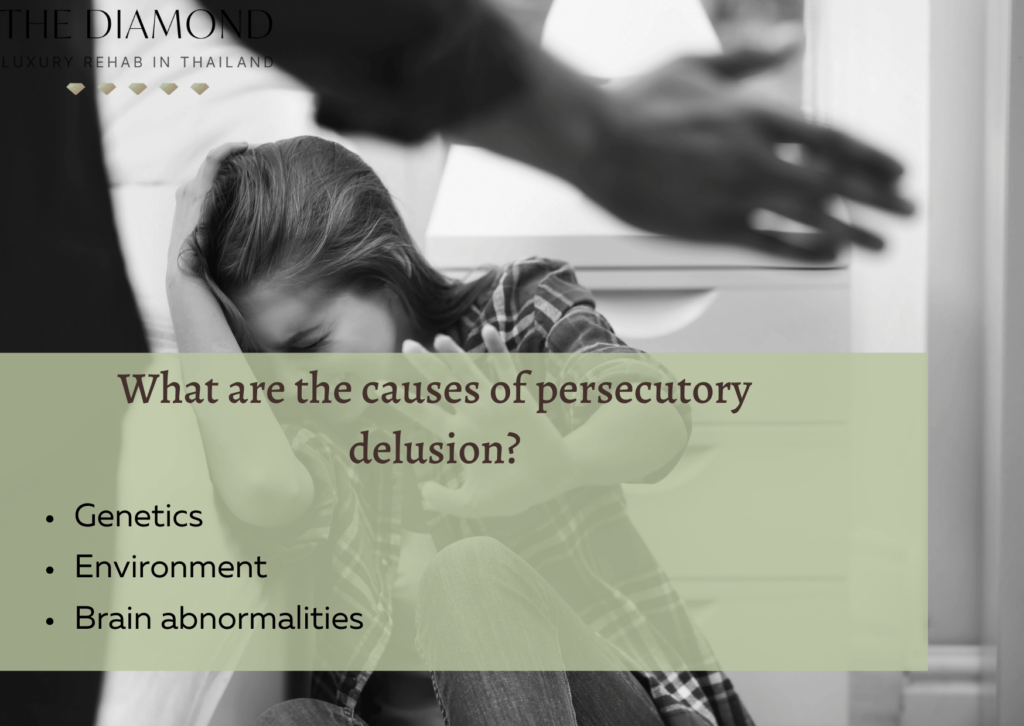
Causes of persecutory delusion are a combination of factors, including other mental illnesses. The most significant causes of persecutory delusion are listed below.
- Genetics
- Environment
- Brain abnormalities
1. Genetics
Genetics refers to a higher susceptibility to developing a specific physical or psychological disease due to a person’s genetic makeup. In an article titled, “Looking at My Genes: What Can They Tell Me About My Mental Health?” last revised in 2020, the National Institute of Mental Health reported that mental disorders tend to have a genetic component.
A single gene is unlikely to cause a mental illness. The concept of the causative gene has been replaced by that of genetic complexity wherein multiple genes in combination with non-genetic factors produce a risk of a mental disorder, according to a paper called, “The genetics of mental illness: implications for practice” from the April 2000 issue of Bulletin of the World Health Organization.
Risk factors for genetics as the cause of persecutory delusion includes having parents with specific genes or mutations that they pass to their children.
Genetics is the cause of persecutory delusion because specific genes and their variations make a person more susceptible to developing this mental problem. Research on this subject is scarce and requires further studies.
Available evidence shows persecutory delusions are, indeed, associated with genetic makeup. For example, a 2005 comparative study by Schulze et al., in the American Journal of Psychiatry found a link between DAOA/G30 locus and persecutory delusions. The term locus refers to the specific physical location of a gene or other DNA sequence on a chromosome.
In this particular study, persecutory delusions were the sole significant factor in explaining the association between the DAOA/G30 risk genotype and symptoms of psychosis. The study included participants with bipolar disorder and showed the link between DAOA/G30 and this mental illness was present only when the scientists focused on cases with persecutory delusions.
A paper by Freeman et al., in the September 2019 issue of the British Journal of Psychiatry Open discussed potential risk factors for persecutory delusion and revealed there is potential for shared genetic propensity.
In its June 2002 issue, the journal Neuropsychopharmacology published a comparative study by Morimoto et al., which found that those with persecutory type delusional disorder had a significantly higher genotype frequency of the D3D2 gene Ser311Cys (21%) compared to subjects with schizophrenia (6%) and healthy controls (6%).
Genetics additionally cause persecutory delusions because it’s strongly associated with delusional disorders in general. In the May 2006 issue of the Canadian Journal of Psychiatry, Debnath et al., revealed an important link between the HLA-A-*03 gene with delusional disorder and paranoid schizophrenia.
The study suggested that the HLA gene may affect a person’s risk of developing paranoid schizophrenia and delusional disorder on its own, in linkage disequilibrium with other HLA genes, or in combination with closely related non-HLA genes. Both include delusions of persecution.
2. Environment
The environment is defined as social factors and those involving a person’s childhood and family dynamics, which contribute to the onset of a mental illness. Both the quality and quantity of social relationships affect mental health, physical health, and mortality risk, according to a paper called, “Social Relationships and Health: a Flashpoint for Health Policy” from the August 2011 issue of the Journal of Health and Social Behavior.
At the same time, in a paper from the November 2017 issue of Innovation in Aging, Thomas et al., showed that family ties offer tools to manage stress, adopt better habits, and boost self-worth, all of which contribute to an individual’s increased well-being.
However, poor relationship quality increases stress and takes its toll on a person’s well-being. In other words, a person’s environment from childhood to adulthood plays a role in their mental health.
Environment-related risk factors in the development of persecutory delusion include childhood trauma, major life stressors, and social isolation.
The environment is a cause of persecutory delusion because it influences the way a person perceives and interprets reality. Evidence confirms that environmental factors play a role in the formation of delusions.
For instance, Schizophrenia Bulletin published a paper by Smeets et al., in May 2015 that showed that factors from the environment, such as childhood trauma and exposure to cannabis, are involved in delusions and their co-occurrence with hallucinations.
Results of a randomized controlled trial by Ellett et al., from the February 2008 issue of Schizophrenia Research found that exposure to the urban environment, as opposed to engaging in a mindfulness task, was associated with heightened anxiety, pessimistic beliefs regarding others, and hasty conclusions in individuals with persecutory delusions. Paranoia increased as well. In high-risk individuals, such an environment exacerbates persecutory delusions or even promotes their development.
A paper by Cosgrave et al., in the April 2021 issue of Translational Psychiatry revealed psychotic experiences such as delusions are associated with environmental aspects such as negative experiences from childhood, obstetric complications, family history, and exposure to trauma.
Exposure to environmental factors increases the expression of psychosis in a dose-dependent fashion, according to a 2016 study by Guloksuz et al., published in BMC Psychiatry.
Mechanisms through which environmental factors alter the perception of reality are specific to each factor. For example, childhood trauma is likely to lead to delusions through biased threat beliefs resulting from trauma-related negative beliefs about oneself and others.
Early parental neglect affects attachment and breeds suspicion of others, which creates the conditions for the development of persecutory delusions, as per a 2018 study by Bailey et al., in the August 2018 issue of Schizophrenia Bulletin.
The same paper reported that childhood trauma doesn’t just contribute to the development of delusions, but it’s associated with more severe delusions in persons with a psychotic disorder as well.
Abusing drugs such as cannabis causes psychotic symptoms, including delusions. A 2017 review written by Ruby S. Grewal and Tony P. George for the Psychiatric Times explained that this happens because cannabis increases dopamine synthesis, release, and reuptake inhibition in a manner akin to the effects of stimulant usage. This explains why taking drugs causes delusions, including the persecutory type.
3. Brain abnormalities
Brain abnormalities are atypical features in brain structure and function or biochemical levels. Scientists believe that mental illnesses result from problems with neurotransmission (communication between neurons), according to a post from NIH Curriculum Supplement Series. Problems with certain brain regions or levels of neurotransmitters could pave the way to depression, bipolar disorder, and other mental illnesses, including psychotic disorders.
Risk factors for brain abnormalities in terms of persecutory delusion are unclear. Mechanisms of action require further research. It is implicated that other factors, such as childhood trauma, cause major stress, which may affect connections in the brain or substance abuse; can also act directly on the brain and its processes.
Genetics is also an important factor here. Science Focus wrote that genetic factors increase the risk of mental illnesses, or make us more susceptible to developing them, by decreasing the brain’s ability to deal with or compensate for disruptions such as trauma.
Brain abnormalities cause persecutory delusions because impaired functioning of certain regions or an imbalance of neurotransmitters affect how a person thinks, feels, and behaves. An article by S. Arjmand et al. in the July 2020 issue of The Neuroscientist revealed that brain areas involved in persecutory delusions include the limbic, paralimbic, and visual processing systems.
The limbic system is involved in emotional or behavioral responses, especially fight-or-flight mode; the paralimbic system participates in emotion processing, self-control, and motivation.
The same paper reported that abolished rostromedial anterior cingulate cortex (integrates emotion and cognition) and higher posterior cingulate cortex (involved in internally directed thought such as memory recollection) could also lead to persecutory delusions.
Neurological dysfunction of the right frontal lobe (involved in voluntary movement, expressive language, and executive functions) is also associated with delusions of persecution. Formation, development, and maintenance of delusions include brain areas such as the dorsolateral prefrontal cortex (involved in executive function, working memory, and response selection), orbitofrontal cortex (participates in motivational, emotional, and social behavior), and hippocampus (regulates learning, memory, and spatial navigation).
The right frontal cortex (involved in non-verbal abilities) is associated functionally with delusions, regardless of their content, according to the abovementioned paper.
In January 2018, The British Journal of Psychiatry published a study by V. Vicens et al. that observed gray matter reductions in patients with delusional disorder. Reduction in the gray matter was present in the medial frontal/anterior cingulate cortex and bilateral insula. Insula is responsible for our ability to perceive pain or be aware of our body and ourselves.
A study by D.L. Perez et al. in the September 2015 issue of the journal Psychiatry Research linked persecutory delusions with amplified neural processing of threatening stimuli and aberrant processing of safety cues in limbic-paralimbic and visual association regions. The study suggests that changes in neural processing can contribute to the development of these delusions.
When it comes to brain abnormalities as a cause of persecutory delusion, it’s important to mention problems with neurotransmitters. The altered transmission of dopamine influences the formation of persecutory delusions, according to a paper by J.M. Barnby et al. in the July 2020 issue of Translational Psychiatry. Dopamine is a neurotransmitter that plays a role in movement, memory, motivation, and pleasurable reward.
Irregularities in the structures and function of the brain, alongside an imbalance of neurotransmitters such as dopamine, can change the way people interpret reality or cope with stress and trauma. This could explain their involvement in the formation of the persecutory delusion. However, brain abnormalities work in combination with other factors such as environment or genetics.
What are the symptoms of persecutory delusion?
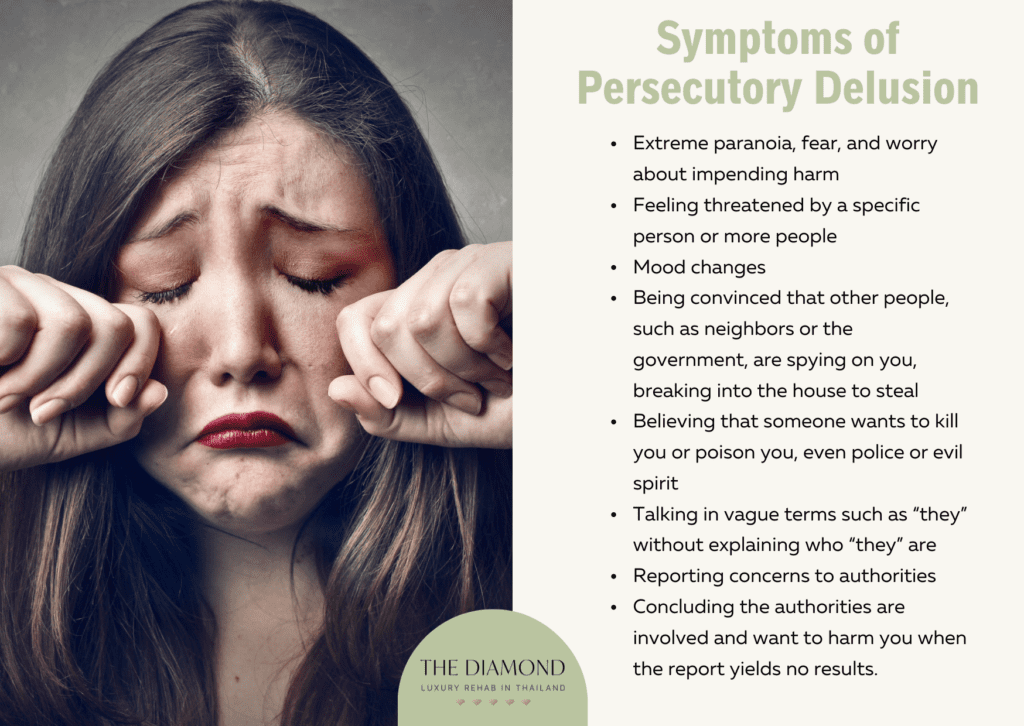
Symptoms of persecutory delusion are associated with a lack of self-awareness, meaning a person doesn’t realize their delusions are problematic. That is the first sign of the presence of a delusion i.e. to the affected individual, their delusion is real, and they are convinced someone wants to harm them. Symptoms of persecutory delusion are listed below.
- Extreme paranoia, fear, and worry about impending harm
- Feeling threatened by a specific person or more people
- Mood changes
- Being convinced that other people, such as neighbors or the government, are spying on you, breaking into the house to steal
- Believing that someone wants to kill you or poison you, even police or evil spirit
- Talking in vague terms such as “they” without explaining who “they” are
- Reporting concerns to authorities
- Concluding the authorities are involved and want to harm you when the report yields no results
- Refusing to believe the evidence presented by other people such as family, friends, or police
- Becoming argumentative, angry, and often violent when other people don’t believe in your delusions
- Becoming frustrated because no one “wants to help”
- Being confused why friends and family don’t share the specific concern (delusion)
Who is affected by persecutory delusion?
People with a history of mental illness, such as schizophrenia and delusional disorder, may experience persecutory delusions. Adults are more likely than children and adolescents to develop delusions of persecution. This is particularly the case for adults with a history of childhood trauma or major life stresses.
What are the risk factors for persecutory delusion?
Risk factors for persecutory delusions are social, environmental, and genetic or biological. However, just because a person has a specific risk factor, it doesn’t mean they are bound to experience persecutory delusion. Delusions are more complicated than that. A combination of several causes and a wide spectrum of risk factors play a role in their development. The most significant risk factors for persecutory delusion are listed below.
- Anxiety i.e., being prone to intense worry and over-analyzing
- Depression
- Childhood trauma, including sexual abuse and bullying
- Being neglected by parents in childhood
- Major life stress
- Cannabis use
- Poor sleep quality and insomnia
- Family history of mental illnesses such as schizophrenia, delusional disorder, and bipolar disorder
- Personal history of bipolar disorder and psychotic disorders such as schizophrenia
- Feeling different, inferior, vulnerable
- High levels of self-criticism and low self-worth
- Enhanced interpersonal sensitivity, i.e., feeling vulnerable in the presence of others due to fear of rejection and criticism
- Irrational reasoning or tendency to jump to conclusions
- Social isolation or loneliness
How is persecutory delusion diagnosed?
Doctors perform a physical and psychiatric evaluation to diagnose persecutory delusion. More precisely, based on the symptoms and description of a patient’s thought process or their version of reality, a healthcare professional can conclude they have persecutory delusion. The main intention of the diagnostic process is to determine the cause of the delusion of persecution.
The main purpose of a physical exam is to check a patient’s physical health for potential or related causes, Healthline explains. The doctor may order blood and urine tests, which can also show whether a patient has been using drugs. Imaging tests such as MRI may be necessary as well.
Psychiatric evaluation is an important part of the process during which a psychiatrist asks questions about a patient’s delusions, feelings, and behaviors. For a better understanding of the patient’s symptoms, a psychiatrist may interview their family member.
A mental health professional uses DSM-5 to check if a patient’s symptoms meet certain diagnostic criteria. That is when they diagnose persecutory delusion i.e. the underlying cause. For example, if persecutory delusion is present for at least one month and a patient doesn’t have schizophrenia or other psychotic symptoms such as hallucinations, a psychiatrist may diagnose delusional disorder, persecutory type.
Diagnostic criteria for schizophrenia include the presence of at least two (out of five) symptoms for at least one month. The symptoms include delusions, hallucinations, disorganized or incoherent speaking, disorganized movements, and negative symptoms (e.g., lack of interest).
These symptoms should be severe to the point they significantly affect the social and occupational functioning of a patient. Persecutory delusion may result from several other mental illnesses, including post-traumatic stress disorder (PTSD), a major depressive disorder with psychotic features, schizoaffective disorder, and bipolar disorder.
That’s why DSM-5 is so important; the diagnostic criteria listed there help psychiatrists pinpoint and accurately diagnose the condition that causes a person’s delusions.
How to prevent persecutory delusion?
There is no known way to prevent persecutory delusions and avoid experiencing them entirely. However, it’s possible to manage the problem and reduce the impact of delusions or prevent complications such as worsening of the underlying mental condition. The best way to make it happen is to adhere to the treatment protocol.
People with trauma from childhood or those dealing with major life stress may want to consider therapy. Regular therapy sessions can help a person process their negative experience in a healthier manner and thereby protect their mental health.
A healthy lifestyle also plays an important role in mental health and well-being, which is why it’s crucial to get enough sleep, eat a well-balanced diet, exercise regularly, and practice mindfulness.
What are the treatments for persecutory delusion?
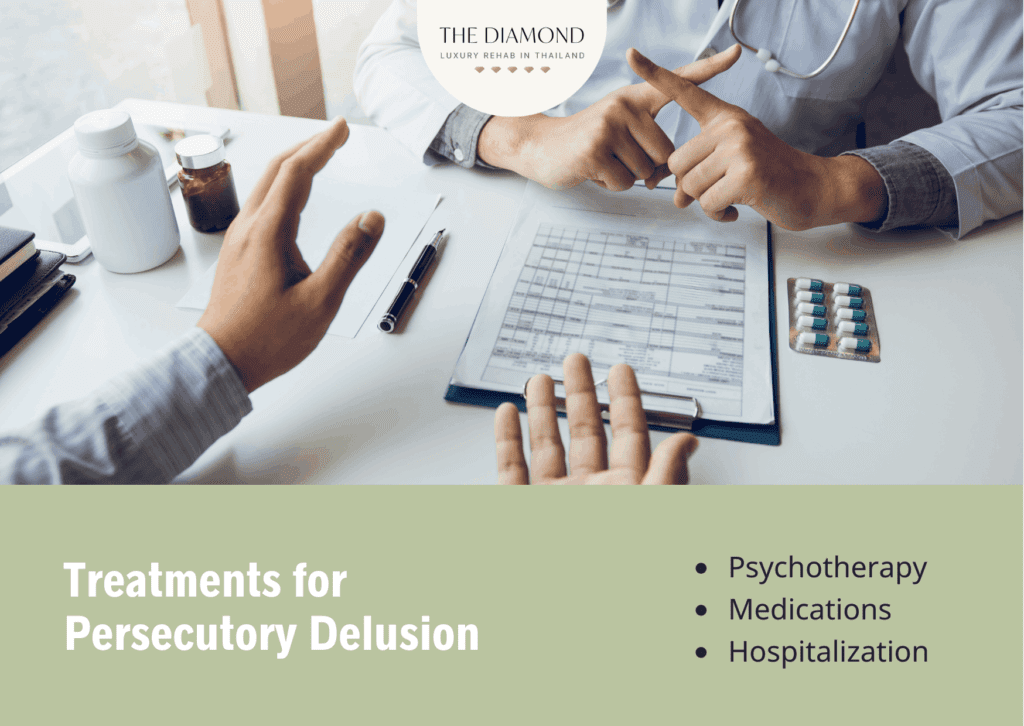
The main treatment for persecutory delusion is therapy. Persecutory delusion is difficult to treat because a patient doesn’t believe they’re the problem. To the patient, delusion seems real and they see no problem with that. In their mind, it’s everyone else who’s wrong on the subject of their delusion. For that reason, a well-structured treatment is necessary. Treatments for persecutory delusion are listed below.
- Psychotherapy: Psychotherapy is concerned primarily with thought processes and delusions. The goal of psychotherapy, such as cognitive behavioral therapy (CBT), is to help patients identify negative or troubling thoughts in order to replace them with more positive or realistic alternatives. The main notion of CBT is that thoughts influence emotions and behaviors. So, changing thought patterns can help improve how a patient feels and behaves. Other roles of CBT are to teach skills that patients can use to improve their functioning. It also educates patients on their mental health problems and how to better recognize reality. Cognitive-behavioral therapy is an effective and evidence-based approach to the treatment of persecutory delusion. In a study from the April 2015 issue of the Lancet Psychiatry, D. Freeman et al. found that CBT significantly reduced worry in subjects with persecutory delusion. It was found that the change in worry accounted for 66% of the change in delusion. In this study, CBT was helpful because it decreased levels of worry, which could be the cause of paranoia. According to an article from Psychiatric Times, CBT teaches patients with persecutory delusions to identify triggers and respond directly to them. A therapist may encourage a patient to cope differently with anomalous feelings to avoid a vicious circle of overreaction and anxiety that leads to unusual experiences in delusion. Beliefs are best changed with experience, which is why behavioral experiments can be utilized to alter delusional beliefs. Patients may get homework to practice the specific skill they learned during the session. The specific number of sessions depends on patients and their needs, but certain patients may need up to 20 sessions. The duration of the initial appointment is 60 minutes, whereas the length of subsequent sessions is 30-40 minutes. Besides individual therapy, patients with persecutory delusions may benefit from group therapy, family therapy, or couples counseling, depending on the severity of their mental condition.
- Medications: Although they are never the first and only option for the treatment of persecutory delusion, medications can help lower the severity of symptoms. The doctor may prescribe antipsychotics, antidepressants, and mood stabilizers depending on the patient’s symptoms and specific needs. In cases of delusional disorder or other psychotic disorders, the most commonly prescribed medications are antipsychotics which can be first- or second-generation i.e., typical or atypical. First-generation or typical antipsychotic medications treat persecutory delusion by blocking dopamine receptors in the brain. Atypical or second-generation antipsychotics block dopamine and serotonin receptors. Studies, such as a paper by A. Miola et al. in the September-October 2020 issue of the General Hospital Psychiatry, found that antipsychotic medications are effective at managing delusions and they have good tolerability. It may take four to six weeks for antipsychotic medications to take full effect. Besides antipsychotics, a healthcare professional may prescribe mood stabilizers to manage a patient’s mood swings and antidepressants to tackle symptoms of depression. Although medications are effective, they aren’t the only treatment option because they work to reduce the severity of symptoms. On the flip side, therapy helps change and improve thought patterns while learning skills and developing healthier coping mechanisms.
- Hospitalization: A healthcare professional recommends hospitalization only when a patient’s persecutory delusion is so severe they are at a high risk of self-harm and harming others. Hospitalization is also necessary if a person is unable to take care of oneself and they’re behaving dangerously. In a clinical setting such as a mental health clinic or a hospital, a team of health professionals stabilizes a patient and keeps them safe. A patient has regular therapy sessions and receives medications under medical supervision. The length of hospital stay varies from one patient to another and how they respond to the treatment.
Do persecutory delusions have a cure?
No, persecutory delusions don’t have a cure that would eliminate them so they never come back. That being said, delusions of persecution can be effectively managed. The treatment is complicated, as mentioned above, and it needs to be ongoing.
A person with persecutory delusions can have a happy and healthy life. For that reason, it is necessary to adhere to the treatment. That is the best way to manage symptoms, develop coping mechanisms, and improve overall functioning.
People with persecutory delusions also need a strong support system. There are many things that friends and family can do to help a person manage persecutory delusions, according to Healthline.
For example, listening to someone with persecutory delusions talk can be difficult, but it’s necessary. Listening helps a person feel understood and respected. Friends and family should avoid disputing or supporting delusions, instead calmly share a different perspective/viewpoint. It is important for patients with persecutory delusions to feel supported, not judged.
Family and friends could encourage a person with persecutory delusions to stick to the treatment and practice coping skills with them.


